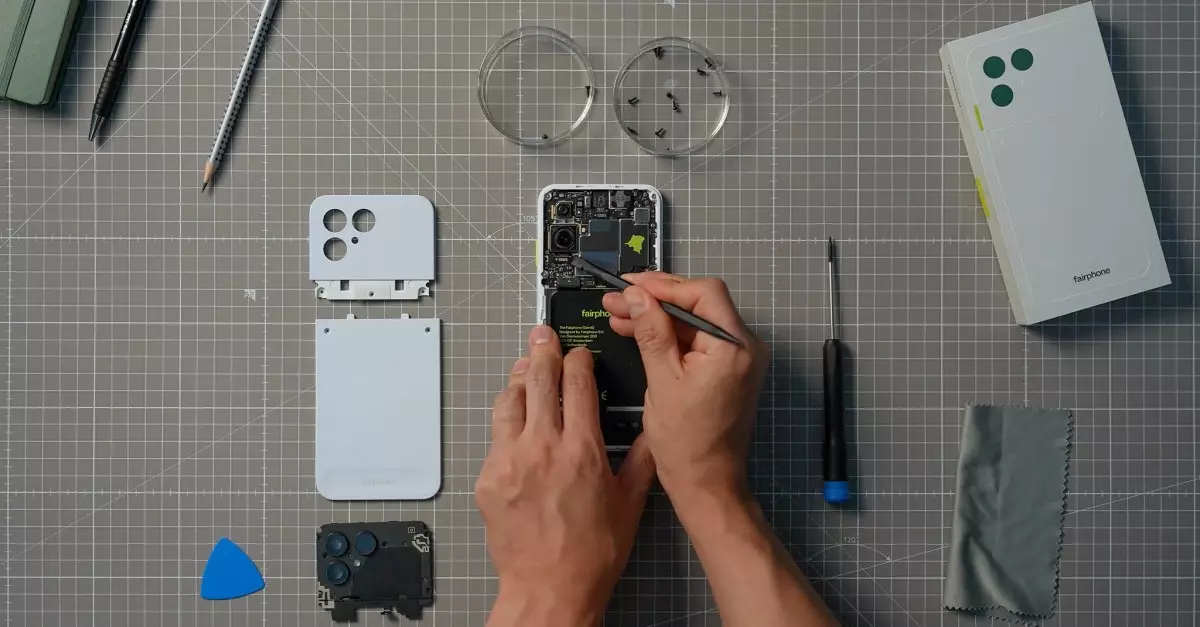The Fairphone 6 boldly reaffirms its position as a trailblazer in sustainable technology by once again earning a perfect score in iFixit’s renowned teardown assessment. This achievement is not merely about durability but signifies a steadfast commitment to user empowerment and environmental responsibility. The company’s philosophy revolves around making repairs accessible, straightforward, and cost-effective, challenging the prevalent trend of planned obsolescence and glued-together devices. By maintaining a high level of repairability despite incremental design changes, Fairphone demonstrates that it’s possible to balance modern aesthetics with longevity.
What truly distinguishes the Fairphone 6 from its competitors is its unwavering focus on modularity. Although it introduces a more compact and streamlined design—reducing bulk and weight—the phone retains a remarkably repair-friendly architecture. The design relies on just seven T5 Torx screws, simplifying battery swaps to mere minutes. This minimal-screw approach minimizes frustration and reduces the tools needed, reinforcing the company’s dedication to empowering users rather than locking them into costly repair services. It’s a bold statement: smartphone repairability doesn’t have to be a compromise on form or function.
Design Philosophy: Balancing Sustainability and Practical Functionality
Opting against the usual trend of minimalist, ultra-slim devices with glued components, the Fairphone 6 embraces a deliberate design that favors longevity and ease of repair. Its smaller form factor marks a shift toward more manageable, pocket-friendly dimensions. Despite the removal of some high-end specs, the core philosophy remains unchanged: prioritize sustainability and user control over fleeting flagship features.
The use of only minimal adhesive, primarily on the mainboard, allows most of the phone’s components—including the USB-C port, individual camera sensors, and the backplate—to be replaced without specialized tools or extensive effort. The company’s choice to keep screw-based assembly over glue is a conscious decision that reinforces its core mission. The IP55 rating further attests to the phone’s durability, offering water and dust resistance without complicating repair procedures. Such durability ensures that users can count on their device lasting years, aligning with Fairphone’s promise of supporting devices for over seven years through operating system updates and security patches.
Trade-offs Between Sustainability and Performance
Of course, a focus on repairability and sustainability does not come without compromises. The Fairphone 6’s specifications illuminate this: its dual rear camera setup is basic, suited more for everyday snapshots than professional-grade photography. The Qualcomm Snapdragon 7S Gen 3 chipset, while efficient, does not compete with the powerhouses reigning in flagship devices. Moreover, the USB port, limited to USB 2.0, might disappoint those seeking swift data transfers or fast-charging capabilities.
Yet, it is precisely these compromises that reflect Fairphone’s prioritized values—longevity and repairability over fleeting high-end features. The 6.3-inch LTPO OLED display, with a variable refresh rate of 10-120Hz, offers a compelling visual experience that balances power efficiency with user engagement. This trade-off positions the Fairphone 6 as a device optimized for users who care more about sustainability and user control than chasing every latest tech trend.
Market Positioning and Global Implications
Pricing-wise, the Fairphone 6 is set at €599 (roughly $705) in Europe, presenting a premium over traditional phones but justified by its repairability and long-term support. In the United States, the pricing jumps to $899, a reflection of limited availability and regional distribution strategies. The exclusive partnership with Murena, offering the device with /e/OS—an innovative, privacy-focused Android alternative—underscores Fairphone’s broader mission: to foster an ecosystem where privacy and repairability go hand-in-hand.
This strategic approach indicates a shift in consumer expectations. As awareness grows regarding the environmental footprint of technology, more users are considering not just the hardware specifications, but also the lifecycle and repairability of their devices. Fairphone, by consistently scoring top marks in iFixit’s teardown tests, positions itself as a leader in this movement, challenging major manufacturers to rethink their standards. The company’s guarantee of up to seven years of OS updates and eight years of security patches is a compelling proposition that could redefine the typical smartphone lifecycle.
Furthermore, the notion of modular accessories and swappable backplates opens exciting possibilities for personalization and sustainability. Users can extend their device’s lifespan by customizing or upgrading components, contrasting sharply with the disposable mentality pervading the mainstream market.
In essence, Fairphone’s continuous excellence in repairability demonstrates that sustainability, user empowerment, and modern design are not mutually exclusive. Instead, they can coexist and even thrive, setting a powerful precedent for the entire industry.

